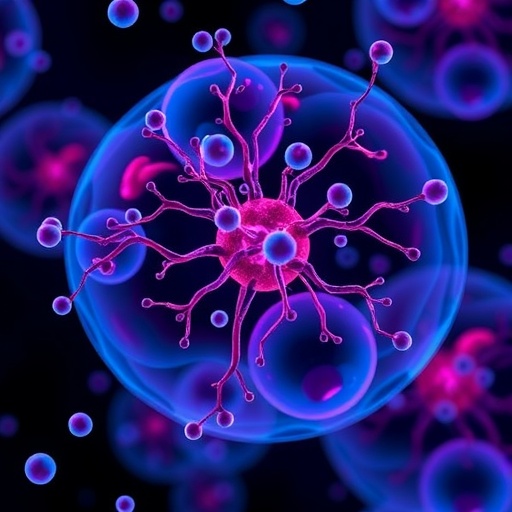In a groundbreaking study published in the latest issue of npj Parkinson’s Disease, researchers have unearthed a compelling link between interferon gamma (IFN-γ) and the coordinated modulation of key enzymatic activities implicated in Parkinson’s disease (PD). This comprehensive investigation, led by Hughes et al., delves deeply into the interplay among LRRK2, GCase, and cathepsins within monocytes derived from both idiopathic and genetic PD patients, unveiling potential mechanistic insights that could pave the way for novel therapeutic interventions.
The study hinges on the immunomodulatory effects of interferon gamma, a cytokine traditionally known for its role in orchestrating immune responses. While PD has long been characterized by its dopaminergic neuronal loss and hallmark motor symptoms, mounting evidence implicates peripheral immune alterations as a critical facet of its pathology. The authors capitalized on this emerging paradigm by examining how IFN-γ influences intracellular pathways contributing to PD pathology, especially focusing on monocytes — peripheral immune cells with known aberrations in PD.
Central to the investigation is Leucine-rich repeat kinase 2 (LRRK2), a multifaceted protein kinase heavily involved in PD pathogenesis, particularly in genetic forms of the disease. Mutations in LRRK2 represent one of the most common genetic causes of PD, but its functional dynamics in immune cells remain incompletely understood. The study elucidates how IFN-γ stimulation orchestrates changes in LRRK2 kinase activity and expression, suggesting that immune activation may exacerbate or modulate LRRK2’s pathological roles beyond neuronal contexts.
In tandem with LRRK2, the study also probes the activity of glucocerebrosidase (GCase), a lysosomal enzyme encoded by the GBA gene, whose mutations markedly increase PD risk, linking lysosomal dysfunction to disease pathology. Intriguingly, IFN-γ exposure triggered coordinated alterations in GCase enzymatic activity, hinting at an integrated response involving lysosomal pathways within monocytes. These shifts may reflect attempts at compensatory lysosomal engagement or conversely, contribute to dysfunctional degradation processes related to alpha-synuclein accumulation.
Cathepsins, a family of proteases pivotal in lysosomal degradation, emerge as another critical node affected by IFN-γ. The investigation found shifts in cathepsin activities, underscoring a possible reprogramming of proteolytic processing within the lysosomal compartment under cytokine stimulation. This suggests that immune signaling can dictate protease dynamics, influencing intracellular protein clearance mechanisms integral to PD progression.
Methodologically, the research employed a combination of enzymatic assays, gene expression profiling, and immune stimulation protocols in monocytes isolated from PD patients with different genetic backgrounds as well as idiopathic cases. This stratification allowed for nuanced comparisons revealing that IFN-γ induces coherent, yet distinct modulatory patterns depending on the genetic context of the disease, emphasizing the heterogeneity of PD immunopathology.
Crucially, the data portray a scenario where immune activation does not merely act as a bystander but actively reshapes molecular pathways underpinning PD. By demonstrating that IFN-γ drives synchronized alterations in LRRK2, GCase, and cathepsin activities, the study underscores the interconnectedness of inflammatory signaling and lysosomal competence, both increasingly viewed as cornerstone elements in PD etiology.
This research also holds therapeutic implications. Targeting IFN-γ signaling or modulating downstream enzymatic activity could present a dual opportunity: attenuating neuroinflammatory cascades and restoring lysosomal function, potentially halting or slowing neurodegeneration. Moreover, these insights may inform biomarker development, with altered enzyme activities in circulating monocytes serving as accessible indicators of disease state or therapeutic response.
Beyond PD, the findings contribute broadly to neuroscience and immunology by illuminating how cytokine milieu can intricately regulate cellular proteostasis components. Given the emerging recognition of systemic immune contributions to neurodegenerative disorders, this study adds weight to the concept that peripheral immune cells are not mere passive elements but active participants in disease-related molecular alterations.
Furthermore, the coordination between kinase activity (LRRK2), lysosomal enzyme function (GCase), and proteolytic processing (cathepsins) as modulated by IFN-γ hints at a tightly integrated regulatory axis, the disruption of which might precipitate or exacerbate neurodegenerative pathways. Understanding the precise signaling cascades and feedback loops involved could unlock future avenues for disease-modifying therapies.
The nuanced responses observed in idiopathic versus genetic PD monocytes also point to the necessity of personalized approaches in treatment development. As we unravel how cytokine interactions shape cellular dysfunction in diverse genetic landscapes, therapies can be more finely tuned to patients’ unique molecular signatures.
Ultimately, this seminal study by Hughes and colleagues forges a vital link tying immune signaling directly to enzymatic activities critical to Parkinson’s disease pathogenesis. Through meticulous examination, their work highlights the complex dialogues between inflammation and cellular maintenance machinery, illustrating how perturbations in this balance manifest within peripheral immune cells and potentially drive central nervous system pathology.
As neurodegenerative research rapidly embraces the immune dimension of disease, such revelations highlight the importance of broadening our investigative lens beyond neurons alone. Peripheral monocytes, accessible and modifiable, emerge not only as a window into disease mechanisms but also as promising targets for intervention in the quest to ameliorate or even prevent Parkinson’s disease.
The journey from this meticulous biochemical and immunological investigation to clinical application will require further exploration. Future studies should dissect the signaling pathways downstream of IFN-γ in monocytes, map the temporal dynamics of enzyme modulation, and evaluate how these changes impact neuronal survival in in vivo models. Moreover, clinical trials targeting these pathways will be pivotal to translating these exciting discoveries into tangible patient benefits.
In conclusion, the interweaving of immunology, enzymology, and neurodegeneration evidenced in this study reshapes our understanding of Parkinson’s disease etiology. Interferon gamma emerges not only as an inflammatory signal but as a master regulator of enzymatic networks crucial for maintaining cellular homeostasis, shining new light on the intricate molecular tapestry that underlies one of the most challenging neurodegenerative diseases.
Subject of Research: Parkinson’s disease; immune modulation of enzymatic activity in monocytes; LRRK2, GCase, and cathepsin interplay under interferon gamma stimulation.
Article Title: Interferon gamma stimulates coordinated changes in LRRK2, GCase, and cathepsin activities in idiopathic and genetic Parkinson’s disease monocytes.
Article References: Hughes, L.P., Wallings, R.L., Agin-Liebes, J. et al. Interferon gamma stimulates coordinated changes in LRRK2, GCase, and cathepsin activities in idiopathic and genetic Parkinson’s disease monocytes. npj Parkinsons Dis. 11, 337 (2025). https://doi.org/10.1038/s41531-025-01185-8
Image Credits: AI Generated
DOI: https://doi.org/10.1038/s41531-025-01185-8
Tags: cathepsins and neurodegenerationcytokine effects on Parkinson’s pathologyenzymatic pathways in Parkinson’sGCase enzymatic activity and PDgenetic factors in Parkinson’s diseaseidiopathic vs genetic Parkinson’s diseaseimmune cell alterations in PDimmune modulation in PDInterferon gamma and Parkinson’s diseaseLRRK2 in monocytesmonocyte dysfunction in neurodegenerationtherapeutic interventions for PD





